This analysis considers the changes in the maritime doctrine of the Russian Federation and the difficulties for the Russian surface fleet in implementing this doctrine. The analysis is made by SouthFront Team under the general editorship of Daniel Deiss.
DEAR FRIENDS. IF YOU LIKE THIS TYPE OF CONTENT, SUPPORT SOUTHFRONT WORK:
PayPal: southfront@internet.ru
Donation alerts: https://donationalerts.com/r/southfront
Gumroad: https://gumroad.com/southfront
Or via: http://southfront.org/donate/ or via: https://www.patreon.com/southfront,
BTC: 3Gbs4rjcVUtQd8p3CiFUCxPLZwRqurezRZ,
BCH ABC: qpf2cphc5dkuclkqur7lhj2yuqq9pk3hmukle77vhq,
ETH: 0x9f4cda013e354b8fc285bf4b9a60460cee7f7ea9
Maritime doctrine of the Russian Federation to the year 2030. Requirements and priorities
Current changes to the global geopolitical map are being fueled by struggles between world powers for control over strategically important logistical communications, corridors, staging areas, and potential markets. One important arena of this struggle are the planet’s oceans, and the key competitors are the United States, China, and Russia. These state actors are reassessing the competition, rethinking military doctrines, and establishing new responsibilities for their armed forces. Of special importance is the development of naval capabilities equal to the tasks set before them. Each of the three main competing powers have their own aims which come from their specific geopolitical position, economic potential, and unique considerations of national security and cultural strategy. In the last several years following Russia’s return to the world stage as a power to be reckoned with, Moscow has significantly revised its approach to challenges and threats. As part of this work on new strategic plans detailing the character of Russia’s naval presence on the high seas, the maritime doctrine was updated and then approved on July twentieth, 2017. The main threat to Russia was identified as “the efforts of a number of states, primarily the United State of America and its allies, to dominate the oceans, including the Arctic, and to establish overwhelming naval superiority.”
The Atlantic is of special interest to Russia due to the increasing economic, political, and military pressure from NATO countries and the consequent sharp reduction in Russia’s capacity to project power in the region. Additionally, Russia’s political and military leadership are striving to strengthen the armed forces in the strategically important Mediterranean and Black seas, which also have repercussions on the Atlantic.
The main priorities of naval policies in the Arctic region are to maintain the Russian fleet’s access to the Atlantic as well as to safeguard exclusive access to the rich natural resources of the continental shelf. The Northern fleet plays a vital role in defense of the state and continued, unhindered economic development.
The importance of the Pacific for the Russian Federation is also huge and continues to grow. The Russian Far East sits on enormous resources but is sparsely populated and largely isolated from the industrially developed regions of the country. This situation is aggravated by the intense economic and military development of neighboring states in the Asia-Pacific region, which has a strong influence on economic, demographic, and other processes in the region.
One area previously ignored in the maritime doctrine but which was included in the revised version devotes attention to Russia’s shipbuilding capacity. The inclusion of this section in the doctrine is due to the critical situation of the naval construction industry and the physical state of the military and commercial fleet. For example, the doctrine estimates that in order to maintain a shipping volume of 1129 million tons, it will be necessary to build 1470 cargo ships with deadweight of 22.9 million tons. Furthermore, 1069 vessels will need to be scrapped and replaced due to aging, and 401 vessels will need to be built in addition to that which exists today.
The doctrine describes how the ability of Russia to effectively react to challenges and threats requires a significant strengthening of the navy and a presence on the oceans.
In order to defend its interests, the navy requires a minimum of two full-fledged aircraft carriers – one in the Arctic and the second in the Mediterranean. This says nothing of the large number of surface vessels which could be needed for other sea zones. The deployment of an aircraft carrier in the Pacific would only be possible in the distant future. So far, it appears that surface groups deployed in distant sea zones are being folded back into existing groups closer to home.
The new doctrine emphasizes the capabilities of naval aviation in relation to nuclear strategy. Without air cover to deal with the likely superiority of enemy anti-submarine aviation, it is impossible to guarantee not only combat readiness but also the deployment of submarines with their ballistic missile payloads which form the main nuclear strike capability of the Russian navy. Missile-carrying vessels and shore-based surveillance aviation as well as anti-submarine aviation would be unable to successfully go into action without fighter cover. Fighter cover is necessary for the combat efficiency of large ships. In turn, surface vessels make possible the deployment and safe return of submarines from combat areas as well as the movement and deployment of paratroopers. The surface fleet plays the defining role in building mine fields as well as mine-clearing operations. The traditional uses for surface vessels include launching strikes on enemy objects within their own territory, defending shorelines from enemy naval forces, and engaging in anti-submarine operations. In these ways, surface vessels perform a number of critical functions on the battlefield. They can carry out these functions independently, in groups, or in coordination with other naval forces like submarines, carrier-born aviation, and the marines.
Due to the important role played by the navy in Russian power projection, the navy and the surface fleet in particular are faced with many critical challenges which must be addressed today or in the nearest future.
While the Russian air force and submarine fleet are equipped to meet their particular challenges, the surface fleet finds itself in a complex and even paradoxical situation. In order to analyze the condition of the surface fleet, it is necessary to survey the current line of surface vessels as well as the construction and modernization plans which are part of the government’s rearmament strategy.
Current state and capabilities of the Russian surface fleet
Project 1143.5 heavy aircraft-carrying missile cruiser “Admiral of the fleet of the Soviet Union Kuznetsov”
Russia’s only ship of this type. Tasked with the destruction of large surface targets and defense of naval assets from attack by enemy carrier-born units and submarines.
- Homeport: Severomorsk, Northern fleet
- Laid down on September first, 1982 at the Black Sea Shipyard and launched on December fourth, 1985. Commissioned and joined the Northern fleet on January twentieth, 1991. In 2018 the ship is undergoing a refit and modernization at the Zvezdochka naval refit center in Severodvinsk.
Tactical and technical specifications of the Project 1143.5 heavy aircraft-carrying missile cruiser “Admiral of the fleet of the Soviet Union Kuznetsov”
- Speed: 29 knots
- Endurance: 45 days
- Complement: 1960 crewmembers
- Propulsion: 4 x 50,000 horse power steam turbines, 9 x 1500 kilowatts turbogenerators, 6 x 1500 kilowatts diesel generators
Size
- Length: 302.3 meters
- Length at the waterline: 270 meters
- Beam: 72.3 meters
- Beam at the waterline: 35.4 meters
- Draft: 9.14 meters
- Standard displacement: 43,000 tons
- Full load displacement: 55,000 tons
- Maximum displacement: 58,600 tons
Armament
- The carrier is equipped with rocket launchers (12 Granit anti-ship cruise missiles and 60 Udav-1 anti-submarine missiles) and the Klinok (192 missiles, 24 launchers) and Kashtan (256 missiles) anti-aircraft missile systems.
- It can carry up to 24 Ka-27 multi-use helicopters, up to 16 Yak-41M vertical take-off and landing fighters, and up to 12 Su-27K naval fighters.
Project 1144 and 11442 heavy missile cruiser
Out of three cruisers, one (Pyotr Velikiy) is in service. The main function of these vessels is to carry out rocket strikes on American carrier battle groups.
Admiral Lazarev
- Homeport: Vladivostok, Pacific fleet.
- The cruiser was laid down on July twenty-seventh, 1978 at the Baltic Shipyard in Leningrad (St. Petersburg), launched on May twenty-sixth, 1981, and commissioned in December 1984. Its status is not released, but it will most likely be scrapped.
Admiral Nakhimov
- Homeport: Severomorsk, Northern fleet.
- The cruiser was laid down on May seventeenth, 1983 at the Baltic Shipyard in in Leningrad (St. Petersburg), launched on April twenty-fifth, 1986, and commissioned on December thirtieth, 1988. Its status is not released, but it will most likely be refitted.
Pyotr Velikiy
The flagship of Russia’s Northern fleet.
- Homeport: Severomorsk, Northern fleet.
- The cruiser was laid down on April twenty-fifth, 1986 at the Baltic Shipyard in in Leningrad (St. Petersburg), launched on April twenty-fifth, 1989, and commissioned in 1998. It is currently in service.
Tactical and technical specifications of the heavy missile cruiser Pyotr Velikiy
- Propulsion: 2 boilers, 140,000 horse power nuclear reactor
- Speed: 31 knots
- Endurance: 60 days of food and supplies, 3 years of fuel (unlimited on nuclear reactor)
- Complement: 655 crewmembers
Size
- Length: 251.1 meters
- Beam: 28.5 meters
- Height: 59 meters
- Draft: 10.3 meters
- Standard displacement: 23,750 tons
- Full load displacement: 25,860 tons
Armament
- AK-130 130mm anti-aircraft gun
- 20 SM-233 rocket launchers
- 12 Rif anti-aircraft guided missile systems (96 missiles)
- 2 Klinok (Kinzhal) anti-aircraft missile systems
- 6 3M87 Kashtan (Kortik) air defense gun-missile systems
- 2 RPK-6M Vodopad 533mm anti-submarine missile-torpedo systems
- Anti-torpedo RKPTZ-1 Udav-1M system
- RBU-12000 Udav-1 and RBU-1000 Smerch-3 rocket launchers
- 2 PU PK-14 150mm anti-missile systems
- 2 heavy Ka-27 Helix-V multi-use helicopters
Project 1164 missile cruiser
Out of the three cruisers of this type, two (Varyag and Marshal Ustinov) are in service. They fill the area between the Project 1144 heavy missile cruisers and the Project 956 destroyers. The main functions of these vessels are to strengthen the capabilities of fleets deployed in distant seas and to destroy enemy surface ships including aircraft carriers. Later on, the responsibilities of the Project 1164 grew to include striking enemy group formations, carrying out assignments from naval command, escorting convoys in distant seas, dealing with submarines, firing on enemy-held shorelines, and providing support to paratroopers.
Moskva
- The cruiser was laid down on November fourth, 1976 at the Nikolayev Shipyard, launched on July twenty-seventh, 1979, and commissioned on January thirtieth, 1983. It is being refitted with a modernized engine system at either the Zvezdochka naval refit center in Severodvinsk or its branch in Sevastopal.
Marshal Ustinov
- The cruiser was laid down on October fifth, 1978 at the Nikolayev Shipyard, launched on February twenty-fifth, 1982, and commissioned on November fifth, 1986. It is in service with the Northern fleet.
Varyag
- The cruiser was laid down on July thirty-first, 1979 at the Nikolayev Shipyard, launched on August twenty-eighth, 1983, and commissioned on February twenty-eighth, 1990. It is in service with the Pacific fleet.
Tactical and technical specifications of the Varyag missile cruiser
- Speed: 32 knots
- Cruising speed: 16 knots
- Endurance: 30 days
- Complement: 480 crewmembers
Size
- Length: 186.4 meters
- Beam: 20.8 meters
- Height: 42.5 meters
- Draft: 8.4 meters
- Displacement: 11,490 tons
Armament
- 16 P-500 Bazalt anti-ship missile launchers
- 2 torpedo tubes
- RBU-6000 Smerch-2 rocket launcher
- 2 AK-130 130mm anti-aircraft guns
- AK-630 30mm close-in weapon system
- 2 Osa-MA anti-aircraft missile systems
- 8 S-300F Rif anti-aircraft guided missile systems
- Ka-25 or Ka-27 anti-submarine helicopter
Project 956 destroyers
Out of the eight cruisers of this type, three are in service. They are Admiral Ushakov (Northern fleet), Buistriy (Pacific Fleet), and Nastoychiviy (Baltic Fleet). Another four (Bezboyazneniy, Boyevoy, Bespokoyniy, Burniy) are awaiting refits. Gremyashiy is to be scrapped. The main functions of these vessels are to suppress small land targets, destroy anti-airborne defenses, destroy concentrations of enemy men and material, provide anti-aircraft and anti-missile fire support for landing forces, and destroy surface vessels in coordination with other fleet elements.
Tactical and technical specifications of the Nastoychiviy
- Speed: 32 knots
- Propulsion: 2 x GTZA 50,000 horse power steam engines, 2 fixed pitch screws
- Complement: 296 crewmembers
- Endurance: 30 days
Size
- Standard displacement: 6500 tons
- Full load displacement: 7940 tons
- Length: 156.5 meters
- Beam: 17.2 meters
- Draft: 5.96 meters
Armament
- 2 AK-130 130mm anti-aircraft guns
- 4 AK-630 30mm close-in weapon system
- 2 P-270 Moskit anti-ship cruise missile launchers
- 2 RBU-1000 Smerch-3 rocket launchers
- 2 Shtil anti-aircraft missile systems
- 2 dual 533mm torpedo tubes
- Ka-27 helicopter
Project 1155 and 1155.1 missile destroyers
Out of the nine destroyers of this type, seven are in service. They are Admiral Panteleev (Pacific fleet), Admiral Vinogradov (Pacific fleet), Admiral Levchenko (Northern fleet), Admiral Tributs (Pacific fleet), Marshal Shaposhnikov (Pacific fleet), Severomorsk (Northern fleet), and Vitse-admiral Kulakov (Northern fleet). Admiral Chabanenko is being refitted. Admiral Kharlamov is in reserve. The main functions of these vessels are battling submarines on the high seas. The oldest ship is Vitse-admiral Kulakov which has been in service since December 1981. The newest ship is Admiral Panteleev which has been in service since December 1991.
Tactical and technical specifications of Admiral Chabanenko
- Propulsion: dual-shaft COGAG turbines, 2 M-63 9000 horsepower gas turbine plants, 2 M-8KF 22,500 horsepower afterburner gas turbine plants
- Speed: 32 knots
- Cruising speed: 18 knots
- Endurance: 30 days
- Complement: 296 crewmembers
Size
- Standard displacement: 7700 tons
- Full load displacement: 8900 tons
- Length: 163.4 meters
- Beam: 19.5 meters
- Average draft: 5.2 meters
- Draft when outfitted with sonar system: 7.9 meters
Armament
- P-270 Moskit anti-ship cruise missile launcher with the Mineral target designation system
- 2 Klinok (Kinzhal) anti-aircraft missile systems
- 2 3M87 Kashtan (Kortik) air defense gun-missile systems
- AK-130 130mm anti-aircraft gun
- Vodopad-NK anti-submarine missile system
- Anti-torpedo Udav-1 system
- 2 Ka-27 anti-submarine helicopters
Project 11540 frigates
Out of the two frigates of this type, one, Yaroslav Mudriy (Baltic fleet), is in service. The Neustrashimiy is undergoing a refit until 2019. The main functions of these vessels are search, detection, and tracking of enemy submarines, provide anti-ship and anti-submarine defense for other vessels, carry out strikes on ships and their bases, support land operations, and protect amphibious landing forces.
Tactical and technical specifications of Yaroslav Mudriy
- Propulsion: dual-shaft COGAG turbines, 2 gas turbine plants with a total 20,000 horsepower, 2 afterburner gas turbine plants with a total 37,000 horsepower
- Power: 57,000 horsepower
- Speed: 30 knots
- Cruising speed: 18 knots
- Endurance: 30 days
- Complement: 27 officers, 31 midshipmen, 155 enlisted
Size
- Displacement: 4500 tons
- Length: 129.8 meters
- Beam: 15.6 meters
- Average draft: 8.35 meters
Armament
- 6 533mm torpedo tubes
- Vodopad-NK anti-submarine missile system
- RBU-6000 Smerch-2 rocket launcher
- 4 Klinok (Kinzhal) anti-aircraft missile systems
- 2 Kashtan (Kortik) air defense gun-missile systems
- AK-100 100mm anti-aircraft gun with MR-145 Lev radar system
- Ka-27 anti-submarine helicopter
Project 1135, 1135M, 11352, 11356 frigates
The following five frigates are in service: Admiral Makarov, Admiral Essen, Admiral Grigorivich, Ladniy, and Puitliviy (all from the Black Sea fleet). An additional three are under development (Project 11356): Admiral Butakov, Admiral Istomin, and Admiral Kornilov. Admiral Butadov launched in 2016, while Admiral Istomin and Admiral Kornilov launched in 2017. They are intended to be in service in 2020 or 2021 with the Black Sea fleet. The main functions of these vessels are combat with surface vessels and submarines, repel air attacks independently or in coordination with other forces, security and strike missions in the Black and Mediterranean Seas, and participate in anti-terrorist and anti-pirate operations.
Tactical and technical specifications of Admiral Makarov
- Propulsion: 2 diesel 30,450 horsepower gas turbines, M7N1 8450 horsepower gas turbines, 4 WCM-800 diesel generators
- Speed: 30 knots
- Endurance: 30 days
- Range: 4850 miles at 14 knots
- Complement: 180 crewmembers and 20 infantry
Size
- Standard displacement: 3620 tons
- Full load displacement: 4035 tons
- Length: 124.8 meters
- Beam: 15.2 meters
- Draft: 4.2 meters
Armament
- 8 Kalibr-NK anti-submarine anti-ship missiles
- A-190 100mm gun emplacement
- 2 (Kortik or Palash) air defense gun-missile systems
- Shtil anti-aircraft missile system
- 8 Igla-1 surface-to-air missile launchers
- 12 RBU-6000 Smerch-2 rocket launchers
- 6 533mm torpedo tubes
- Ka-27 or Ka-31 helicopter
Project 22350 multi-role frigates
One ship of this type is in service, the Admiral Flota Sovetskogo Soyuza Gorshkov (Northern fleet). An additional three are being developed: Admiral Flota Kasatonov, Admiral Golovko, and Admiral Flota Sovetskogo Soyuza Isakov. These vessels are the navy’s backbone in the Arctic, Atlantic, and Mediterranean.
The lead ship Admiral Flota Sovetskogo Soyuza Gorshkov has been in service since July 2018. Admiral Flota Kasatonov has been launched and it is planned to enter service in 2019. Admiral Golovko was laid down in 2012 and Admiral Flota Sovetskogo Soyuza Isakov was laid down in 2013 with both launches planned for 2020.
Tactical and technical specifications of Admiral Flota Sovetskogo Soyuza Gorshkov
- Speed: 30 knots
- Endurance: 30 days
- Range: 4850 miles at 14 knots
- Complement: 180 crewmembers and 20 infantry
- Full load displacement: 4500 tons
- Length: 135 meters
- Beam: 15 meters
- Draft: 4.5 meter
- Propulsion: 2 diesel 30,450 horsepower gas turbines, M7N1 8450 horsepower gas turbines, 4 WCM-800 diesel generators
Armament
- Kalibr-NK anti-submarine anti-ship missiles with 32 Oniks or Kalibr missiles
- Paket anti-submarine system
- A-192 130mm cannon
- 2 Palash air defense gun-missile systems
- Ka-27PL helicopter
Current numbers
The Russian Navy’s surface fleet, which is in service and ready to carry out operations in the second half of 2018, is as follows:
*In the second half of 2018, the Russian Navy had no combat ready aircraft carrier (heavy aircraft-carrying missile cruiser)
The Russian Navy’s submersible fleet, which is in service and ready to carry out operations in the second half of 2018, is as follows:
It is clear from this information that the Russian Federation’s surface fleet is not ready to carry out its obligations according to the Maritime Doctrine – 2030. In reality, it is one strike group which has been spread from the Atlantic to the Pacific. It is unable to react to threats in an effective and timely manner. In order to gather these forces in one combat theater would take a month at minimum. Expecting the surface fleet to fulfill its responsibilities under the Maritime Doctrine – 2030 is unrealistic. It bears mentioning that a large part of the fleet has aged and modernization given economic realities is doubtful.
Russia’s state rearmament program
Now we will look at how the development of the surface fleet will meet the challenges specified by the rearmament program.
About 4.7 trillion rubles has been appropriated for the navy’s modernization from 2011 through 2020 with an additional 2.6 trillion rubles designated for the army. These plans call for entry into service of 10 Project 955 missile cruisers, 10 Project 885 nuclear submarines Project cruise missiles, 20 non-nuclear submarines including 6 Project 636.3 diesel-electric submarines and 14 rebuilt Project 677s, 14 frigates including 6 Project 11356s and 8 Project 22350s, 35 corvettes including 18 Project 20380s and 20385s with the others being anticipated future versions.
This construction program is the most ambitious rearmament since the fall of the Soviet Union. The state rearmament program 2011-2020 (GPV 2011-2020) includes a construction program for a coastal fleet, designed not only to defend Russia’s shores but also to defend Russia’s interests in deeper waters. This program is the only area in which there has been no progress made under the Maritime Doctrine to 2030. The GPV 2011-2020 is turning out to be entirely unrealistic both in terms of construction capacity and the ability to finance these projects. In 2015 and 2016 it became clear that the budget and military industrial complex were inadequate and that additional funding for the GPV is impossible.
The revised GPV 2018-2027 determined that each branch of the military would receive roughly the same resources. It also takes into account Russia’s actual ship-building capacity and emphasizes work on submarines and smaller vessels like corvettes and frigates. A key point of the naval part of GPV 2018-2027 will be the construction of coastal vessels armed with cruise missiles, strategic missile submarines, and lastly multi-role submarines – to be developed in that order. In this way, the new GPV addresses both open and closed seas.
What hapened to planned surface vessels included in GPV 2011-2020 but are absent in GPV 2018-2027
The Project 23000 Shtorm nuclear aircraft carrier was not included in GPV 2018-2027. In May 2018 a source in the Russian Navy explained that a concrete decision on development of a new aircraft carrier and preparation of the project’s documentation would begin in 2019. It is possible that this aircraft carrier could be laid down in 2021 or 2022 and preliminary estimates say its construction would take about ten years. Blueprints indicate the vessel would have a displacement of 80 to 90,000 tons, a length of 330 meters, beam of 40 meters, and draft of 11 meters. It could carry up to 90 aircraft and 3000 missiles and bombs. Which company would build the project has not been indicated. By the most optimistic estimates, work could not begin earlier than 2022.
The Project 23560 Lider destroyer finds itself in a similar situation. Unlike the aircraft carrier, all work on this project has been postponed until after 2025. In January 2018, a source in the Russian Navy explained that technical and design work on the Lider is set to begin after 2020 with construction of this lead ship to begin in 2025 by the firm Severnaya Verf (St. Petersburg). The vessel will have a displacement of about 17,500 tons, length of 200 meters, beam of 20 meters, and a maximum speed of 32 knots. Lider’s armament will include 60 anti-ship cruise missiles, 128 guided missiles, and 16 anti-submarine guided missiles. Severnaya Verf is planned on building two helicopter carriers and then beginning construction of the destroyer. Development work on the helicopter carriers will begin in 2018, with construction beginning in 2020 and launch set for 2024.
Challenges with the naval surface fleet
What is causing the gap between plans and reality in GPV 2011-2020 and GPV 2018-2027? There are several main reasons.
Personnel. It’s not a secret that the navy suffered more than other branches from the fall of the Soviet Union. The navy today has a serious manpower shortage. The average age of its staff is 55-57. 30% of its specialists are older than 60. There is a major lack of personnel between 35 and 45. The shortfall in technical engineers in the industry is at 17%, construction engineers at 22%, and specialists in a variety of fields up to 40%. By way of comparison, the aviation and tank industries did not lose their personnel between 1990 and 2000, and they fulfilled their obligations under GPV 2011-2020 and are fulfilling them under GPV 2018-2027. This is due to export orders worth billions of dollars. This allowed personnel to be maintained, occasionally factories modernized, and cooperation between corporations in the industry continued. Military ship-building of anything significant for the surface fleet more or less came to a halt during this period. Modernizations and technical service was continued for exported ships but this clearly was insufficient to allow the navy to fulfill its GPV requirements today.
Industrial capacity. Since the collapse of the USSR, the Russian ship-building industry has not produced anything on the scale of the Project 23560 Lider. Neither the USSR nor Russia built a full-fledged aircraft carrier. The industry, which already has a lack of experience, could encounter problems which would lead to long delays in production. These issues are not visible during the planning phase. The initial planning for the Project 23560 Lider destroyer did not take very long, which is the only source of optimism to the naval command. New issues may arise in the near-future during the engineering design phase. Among other things, difficulties should be expected in the planning and development of specific components. Issues in this project which could arise in a number of areas, negatively reflect on the entire destroyer building program. Issues with the armaments and electronic systems cannot be ruled out either.
Added to the fray could be the search for a suitable location to build the Project 23560 lead ship and others of its class. Few Russian shipyards are equipped to build such a large vessel and existing capacity is already backordered for the next several years. As a result the navy and military industrial complex will have to plan the construction of large vessels around the industry’s current and future abilities.
Funding. According to a number of Russian experts, the process of creating a single aircraft carrier would cost 350-400 billion rubles (at 2018 valuation). Including the aviation component and group ships, the price tag passes 1 trillion rubles. The cost of reconstruction of existing industrial space for building large naval vessels would be astronomical and Russia does not have the money nor will it have the money in the near future.
Technology. A number of critical technologies for building an aircraft carrier in Russia today are lacking. There is no shipborne aviation with long-distance radars, shipborne anti-submarine aircraft, or sudden take off and vertical landing aircraft even under development. It is possible to do these things but it would cost additional billions of rubles and years of R&D.
Engines. As long as engineering work on ocean-going vessels has not even started, it is pointless to talk about the power plant for destroyers or aircraft carriers. There is more hope for the Russian fleet to produce gas turbine engines for smaller surface vessels and the future construction of large ocean-going ships depends on their success in this. According to information from the Rybinsk manufacturer, Saturn, they have built at least four M90FR engines for Russia’s navy and one for testing. Furthermore, two gas turbine engines for the last two Project 22350 frigates are already complete and are awaiting the delivery of reduction drives. The company has also built at least three M70FRU engines which are presumably for the Project 11356 frigates. Despite this, some Russian experts doubt the operational readiness of these first of their series gas turbine engines as prototypes still need to be tested. It is likely that the delay in the completion of the Project 23560 is due to waiting on the results of government tests.
Challenges in the areas of organization and planning. After a delay of several years, the refit of the only Russian aircraft-carrying cruiser, Admiral Kyznetsov, began. It is planned to be undergoing this refit and modernization from 2018 until 2020. However, the condition of the Russian shipyards is such that there is a risk of serious delays similar to that which plagued the nuclear missile cruiser Admiral Nakhimov, which was supposed to return to service in 2012 but which in fact began its refit in 2015 and may not be completed until 2021. Out of the large ships undergoing a refit and modernization in this decade, only the missile cruiser Marshal Ustinov completed the process successfully and even at that, the process which was expected to take three years ended up taking more than five. Furthermore, the modernization work was limited especially if you don’t count the radar outfit. The PKR P-500 Bazalt was replaced with the more up-to-date (but still developed during the Soviet period) P-1000 Vulkan, while the other armaments stayed the same.
Bases and resupply points. Another difficulty of developing an ocean-going fleet with an aircraft carrier is that Russia lacks a network of military bases overseas like that which supports US naval power. Of course, these open seas ships have a great deal of autonomy but on long voyages they still need to take on new stores of water and food and make routine repairs.
The Russian ship-building industry is the most troubled out of the entire military-industrial complex. Its number of failed programs is as bad as that of the space industry, keeping in mind both its military as well as civilian parts. Unfortunately, the current state of military ship-building does not engender optimism. With the exception of specific companies, the industry as a whole is in a crisis which leads to catastrophic delays in the majority of programs.
Paths to solving the issues in the military ship-building industry
To remedy the deficit in personnel in the military-industrial complex will take years. In the last few years, the Russian leadership has encouraged development in this area through the setting of legal norms in the training of new personnel. This comes in addition to legislation “About education in the Russian Federation” and a Presidential Order from October fourteenth, 2012 on increasing the ability of the state to support worker organizations in the defense industry. It’s important to understand that resolving any given problem in planning or construction will require specific specialists. In other words, decisions have to be made now about what kind of fleet is needed and then how many and what kind of specialists to train. Even if these processes are successfully realized, training the necessary personnel for an area will take years, if not decades.
A number of specialists investigating various ways of solving these problems in the industry are taking in account the Korean experience with building large ships like supertankers and super containerships. Korea took a path of intensive scientific and technological progress and implementation of innovations in ship-building. The main risks with this strategy are from the development of knowledge economy, or more to the point, from the rate of growth compared to the rate of production of the main competitors. It demands not only the uninterrupted import of technology from abroad, but also the development of a scientific and engineering base inside the country. Especially for construction of large, specialized purpose open-sea vessels where the amount of imported technology is large, the work is just a question of assembly and the Korean companies play a minor role in the actual development process. The reality of Russia’s position today disallows this sort of strategy, particularly for the construction of a modern navy.
Shipyards certainly will not be able to find space before the end of this decade more the construction of the Project 23560 Lider destroyer, to say nothing of building an aircraft carrier. Possibly for this reason the country’s leadership and naval command decided not to hurry the process. It makes sense to study the engineering and construction decisions made on analogous enemy ships and prepare the technical response in Russia’s own ships in order to level the playing field as much as possible. In this case it would be better to invest in research and technological development such as missile systems, strike coordination systems, and unmanned aerial vehicles. At the same time existing systems should be modernized and if resources allow, ships of whatever type can be built over the course of seven or eight years. Following on this it would be reasonable to begin the development of just one series of frigate.
Concerning the propulsion for the proposed aircraft carriers and destroyers, it may not make sense to develop a gas turbine engine from scratch for these types of ships. Warships in distant waters with gas turbine engines would be extremely reliant on refueling. For the US Navy which has a network of bases and supplies, this is not a problem. However, the Russian Navy would be better served by building ships with nuclear propulsion. For example, the KN-3 TARKR reactors from the Project 1144 Pyotr Velikiy were developed on the foundation of icebreakers’ OK-900 reactors. Today, next generation RITM-200 reactors are used in the new LK-60Ya icebreakers (Arktika, Sibir, and Ural). They are lighter and more compact than the OK-900, but operate for three times as long and use 80% as much fuel. It needs to be refueled every seven years (as opposed to ever 2 or 3 like the OK-900) using civilian 20% enriched uranium, however it never needs to be refueled using more heavily enriched uranium. Probably the entire military-industrial complex is practical applications for the RITM-200 reactor so with modifications it could be installed on the destroyers. The first icebreaker sporting the type of propulsion system should enter service in 2019.
Speaking of existing gas turbine engine models, the implementation of their mass production is one example of successfully and quickly replacing Ukrainian production. Another example of fairly quickly developing domestic capacity was the production of VKhD water-water coolant systems and MKhD water-oil coolant systems. Russian diesel engines are constantly becoming more reliable. In 2017 the Kingiseppskiy Machine-building Factory officially announced the launch of the diesel family M-50 and M-500. According to the results of a comprehensive audit, the company presented the necessary technological processes in the manufacturing of components for marine engines of various sizes, including the ChN18/20 and ChN16/17. In this industry it is much more important to develop the processes, modernization, and construction of diesel engines for ships of smaller displacement. Balance needs to be found between constant regulation of the industry and at the same time maintain competitive conditions. The first half of this can be accomplished with the establishment of a center to monitor the industry which will process details about the pace of work and fulfillment of government defense contracts. This type of control would provide alerts about problems and allow for additional material and financing to be directed at those issues. Stimulating competition in the industry is a much less familiar task for the Russian military-industrial complex. Today, the industry is essentially a monopoly and naval command lacks influence over it in the case of delays or quality issues. Increasing competition would prevent situations like a practically finished ship not being put into service because its engines are faulty.
As for bases and supplies, some historically active bases could be reinstated with some countries in Africa and South-east Asia.
Conclusion
Considering the preceding analysis, the Russian surface fleet is currently unable to effectively realize the demands of the Maritime Doctrine to 2030. This is due to a whole series of problems such as a lack of personnel, the loss of industrial capacity, and the lack of a space in which to build aircraft carriers and other large ships. On top of this, the condition of fleet itself is deteriorating. The remedies applied by the Russian leadership have not been enough. Following the logic in GPV 2018-2027 and the actual condition of the Navy’s surface fleet, by 2030 Russia could lose components of the fleet which are able to independently and effectively act on open-seas. Of course as a branch of the armed forces, the Navy will still exist, but the maximum which could be expected would be the defense of its own bases and parts of the Russian coast with demonstrations in seas close to Russian territory. Furthermore, the ability of the Navy to carry out one of its most important tasks, the deployment of naval strategic nuclear forces, would be put in doubt. Nuclear and diesel submarines deployed without surface cover are defenseless and blind.
On the other hand, there are many signals that the military and political leadership clearly understands these issues and how things stand in the Navy, and place high importance on the development of naval power.
The Russian leadership is planning to develop the fleet for asymmetrical containment using modern twenty-first century technology like that which President Putin recently unveiled to the world. These plans include automation of manned and unmanned naval systems, unmanned surface ships and submarines, modern torpedoes and missiles, and weapons based on new principles of physics.
Concerning the ocean-going surface fleet, the technical redevelopment of shipyards, training of personnel and specialists, and R&D on potential projects will all have to be waited on. Only then can the modernization of the fleet really begin.
Therefore, for the foreseeable future, the surface fleet must defend Russian waters with corvettes and frigates. To discuss a growing Russian naval presence on the high seas in the near-term would be premature. The surface fleet could at most carry out one campaign or one extended tour on the oceans.
The situation that meets this definition right now is the Navy’s deployment in the eastern Mediterranean Sea as part of the Syrian intervention.
An effective presence on open-seas will not be possible earlier than 2030 and only if current naval funding and other defense programs are maintained at their current levels.




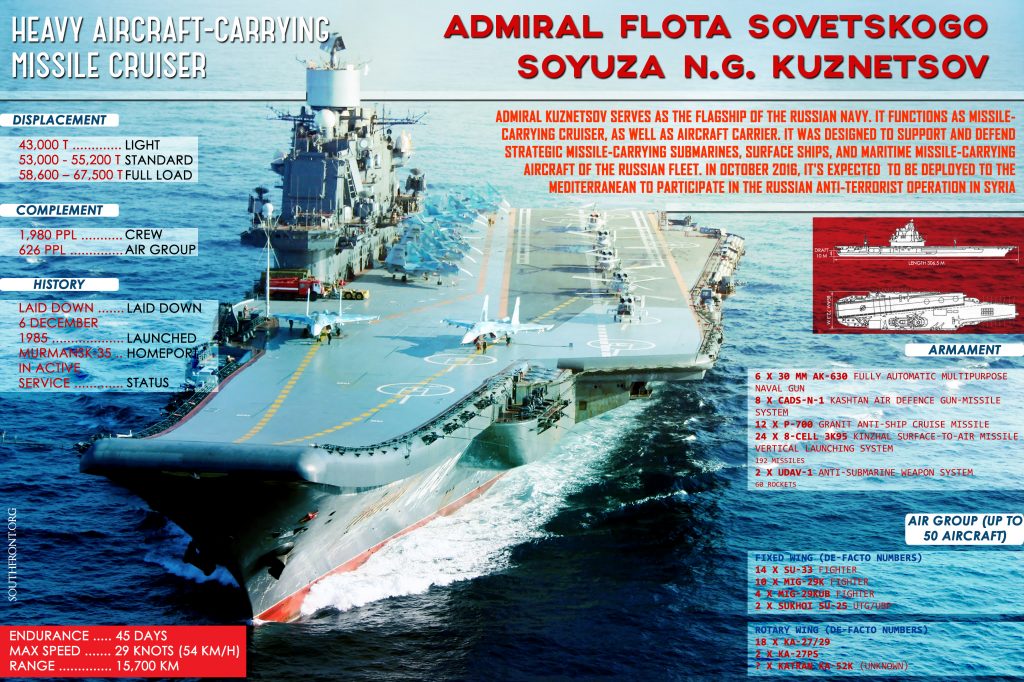
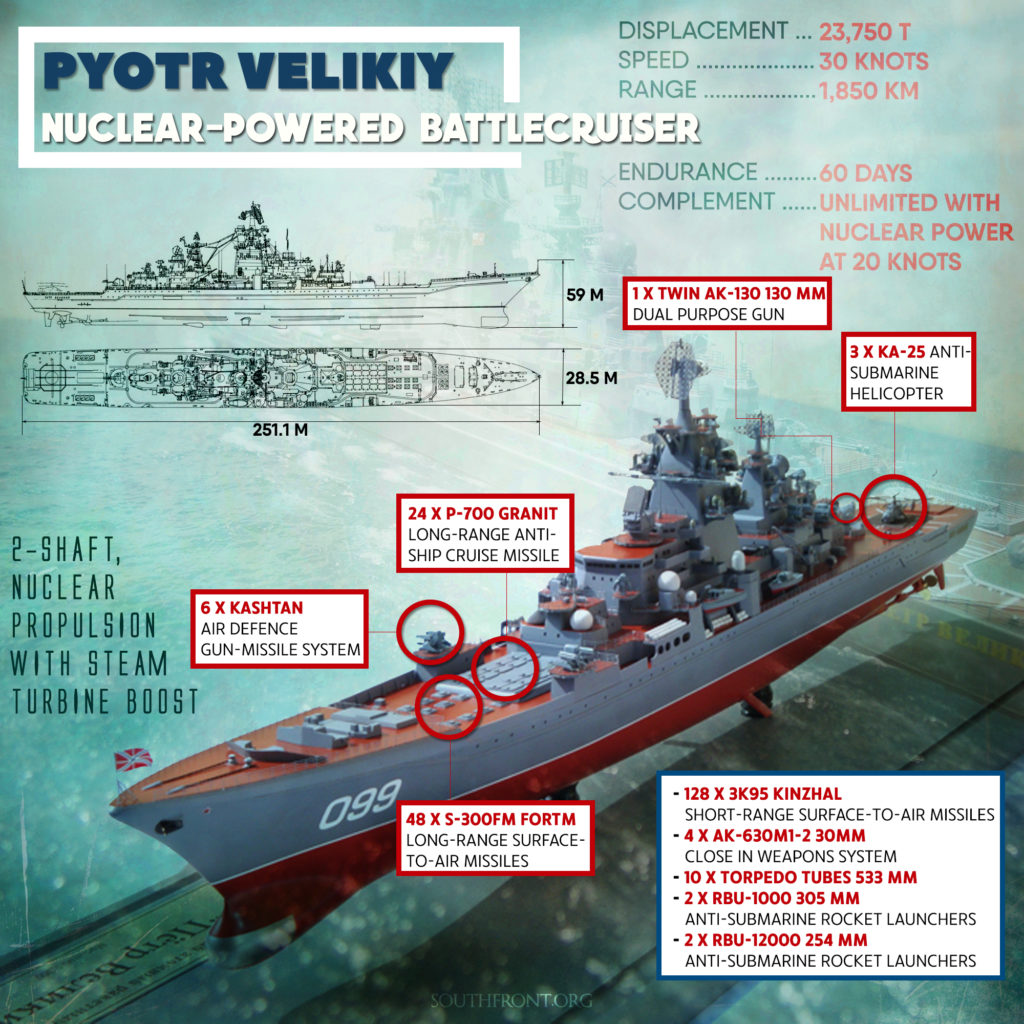
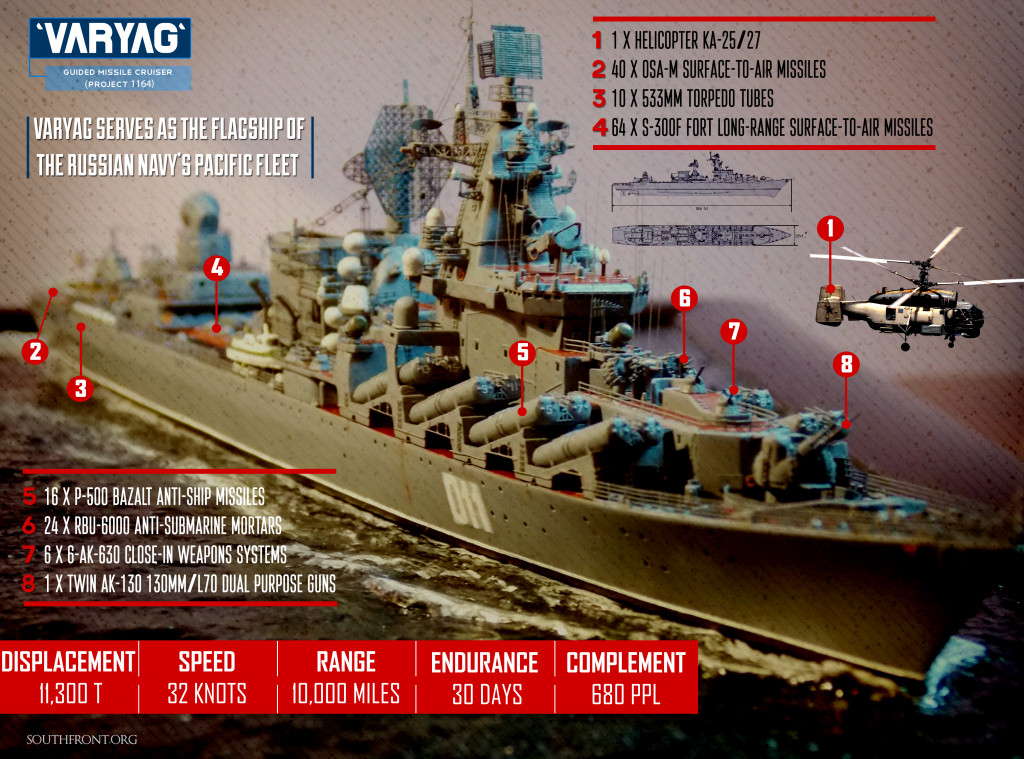
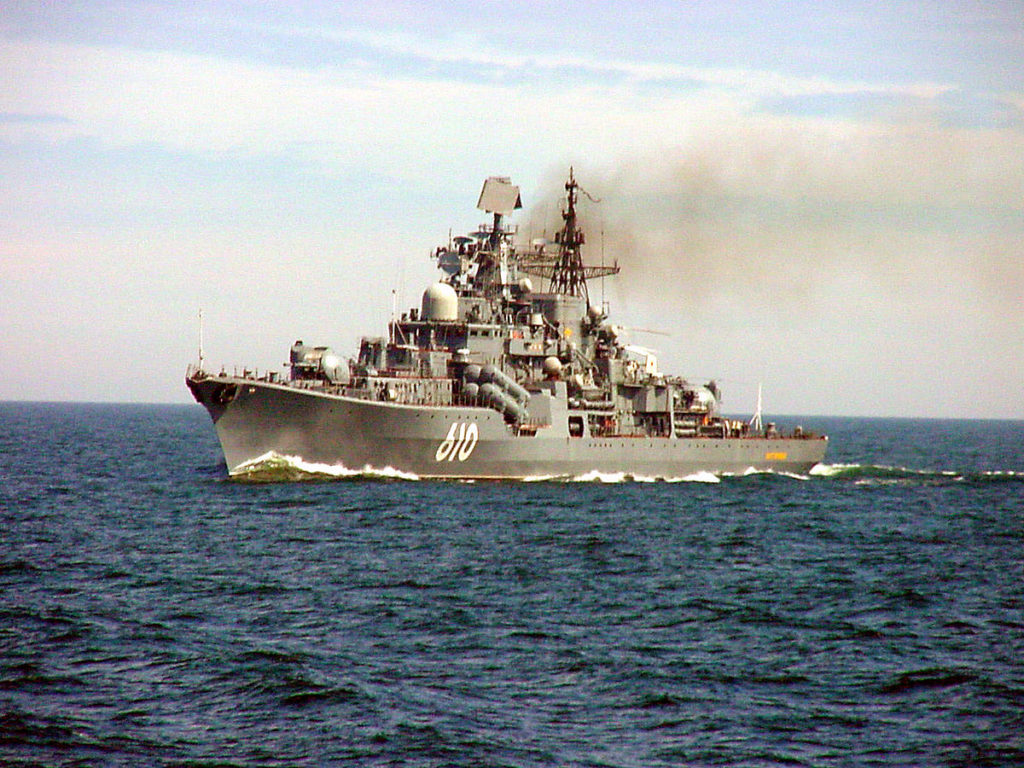
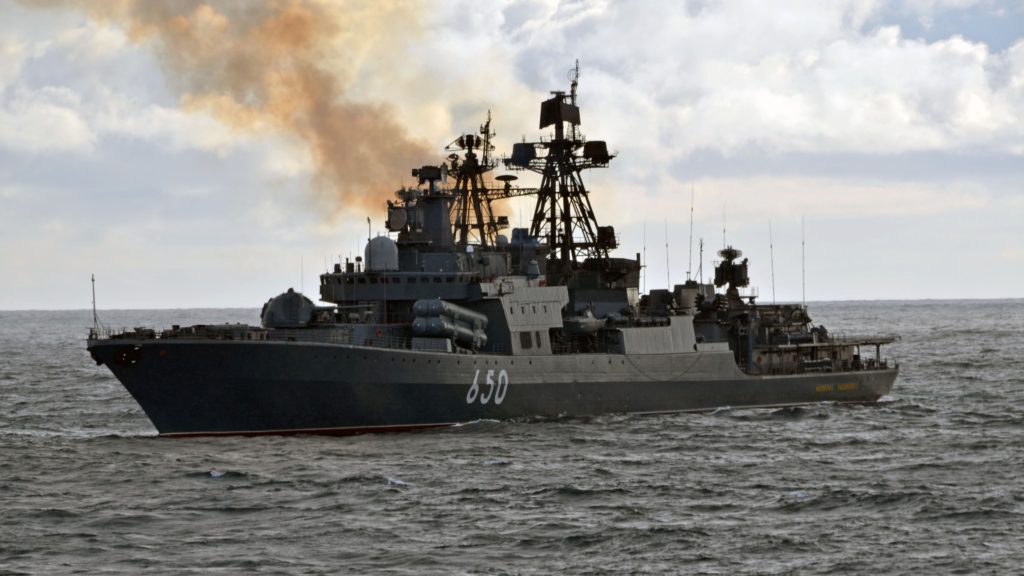

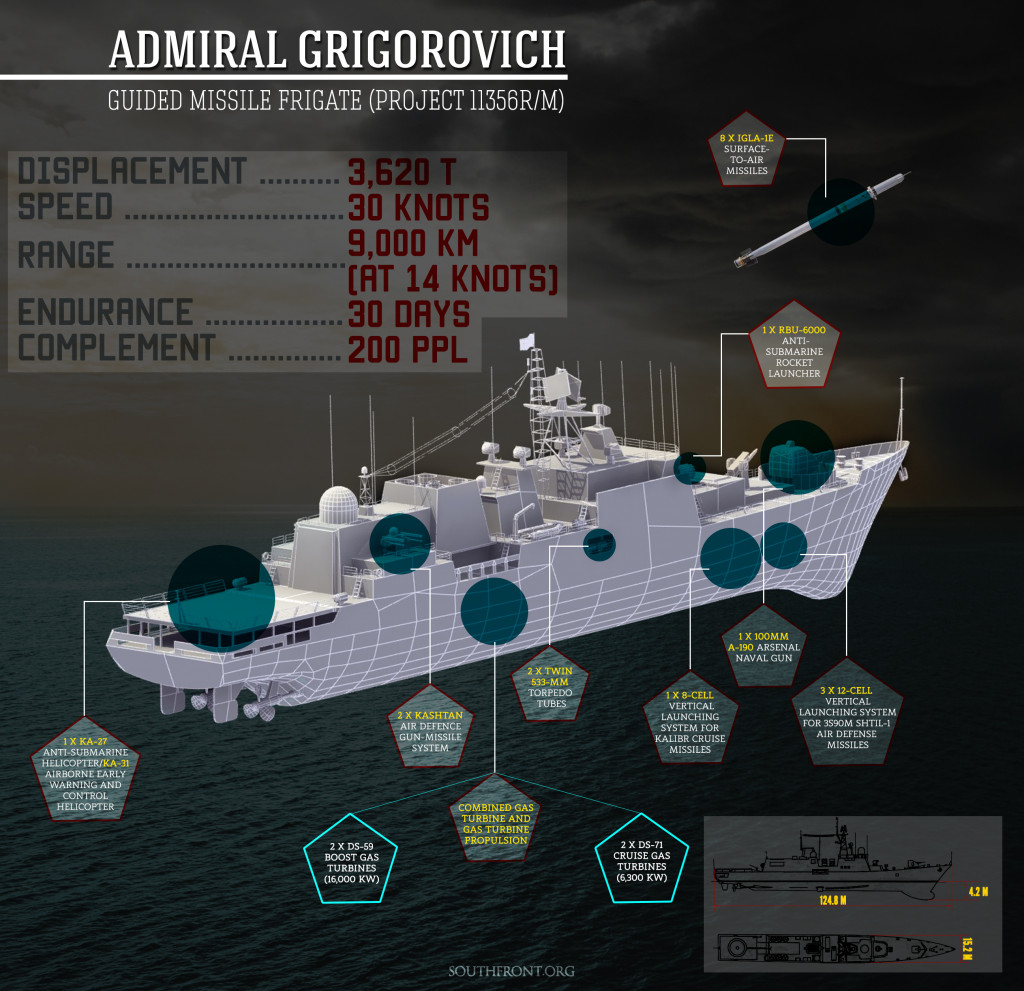




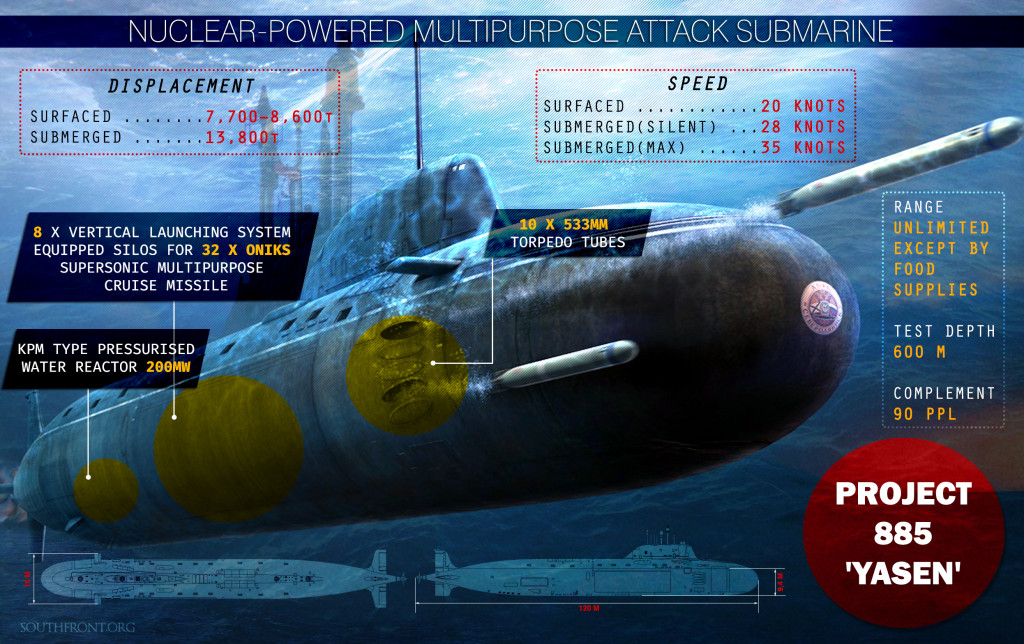
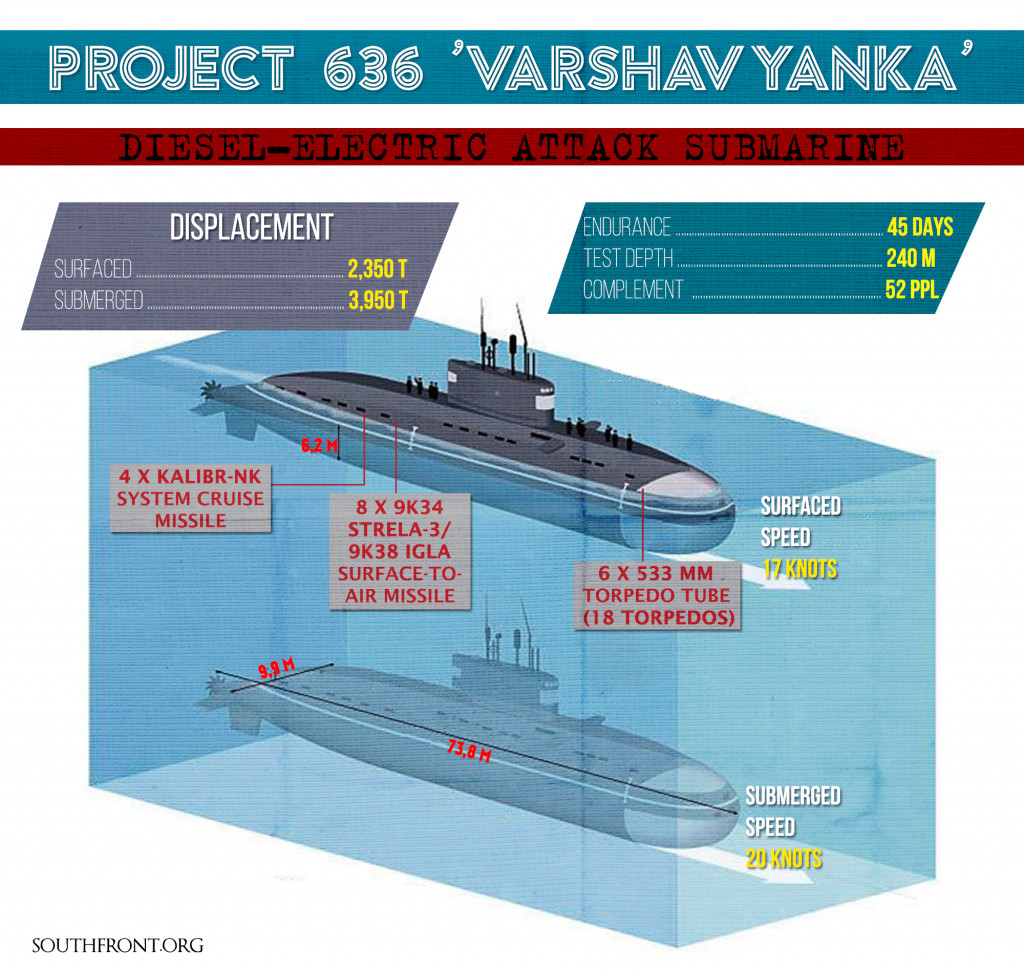
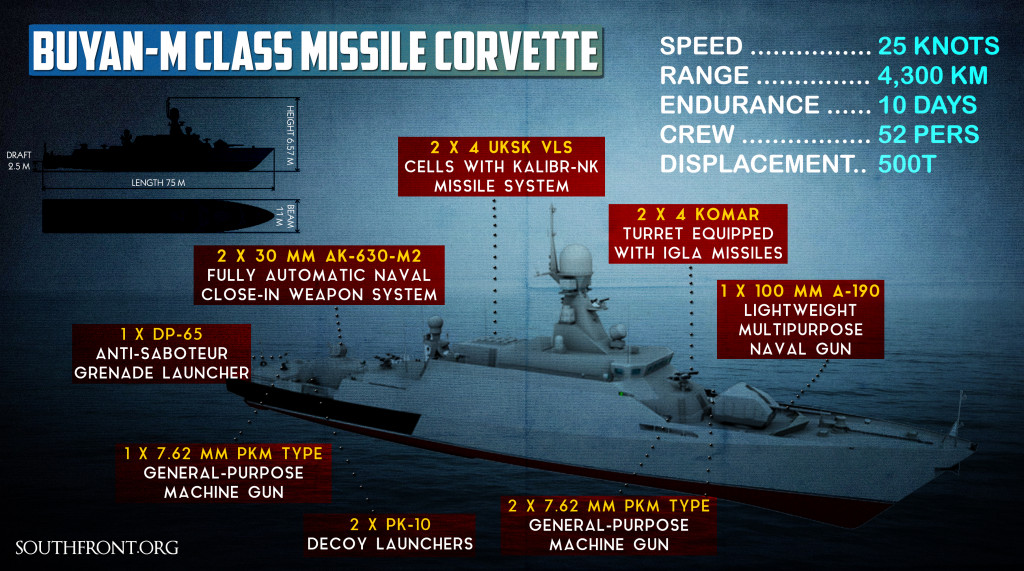

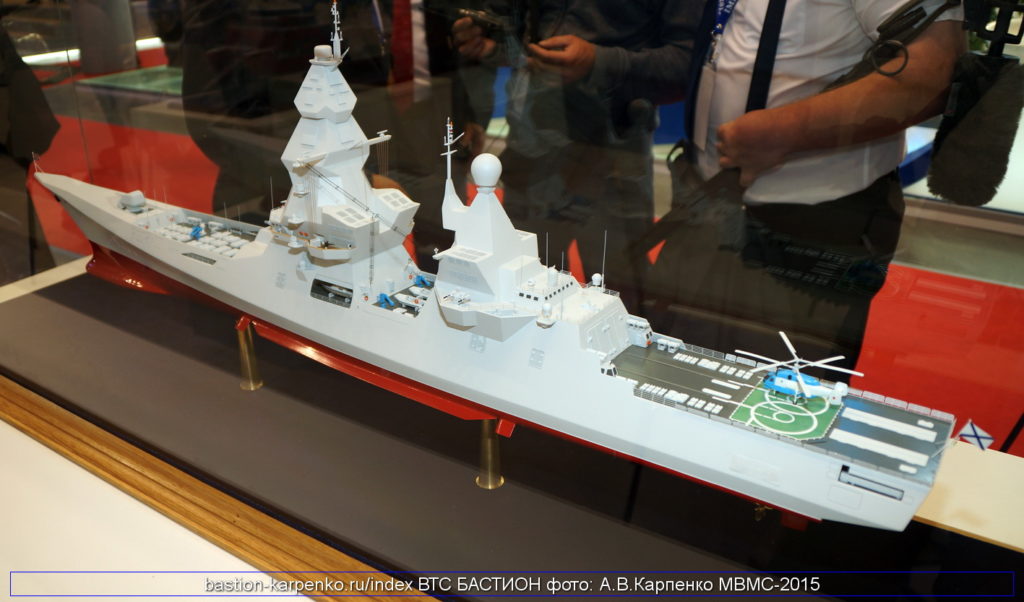
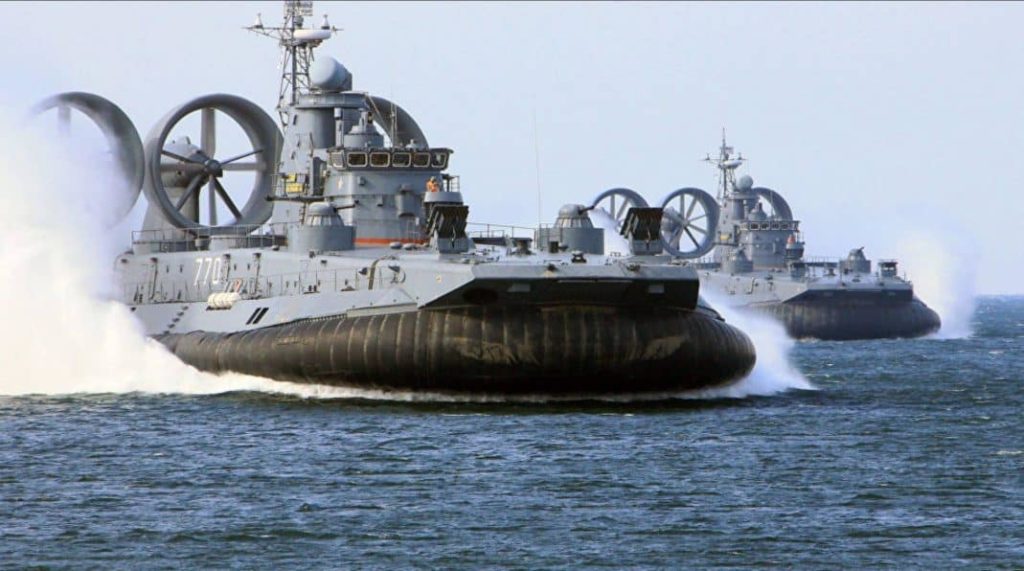



Why on Earth would Russians invest in navy and such when they have no chance on catching the neo-Cons? And no money. They are 200 years ahead.
The only thing Russians should build is ROCKETS! Build only fast nuclear rockets and a billion of them…
Rockets and satellites is the only chance for survival.
Not sure I’d go quite that far, but certainly I’m pretty iffy about aircraft carriers. Every time I hear the term “aircraft carrier” in relation to the American ones, it’s right near the world “obsolete”. I don’t see how Russian ones would be less vulnerable to missiles than American ones.
If I were building a navy right now, I’d emphasize small cheap boats, just big enough to carry some electronics and some missiles. No armour, no real defensive capabilities–they don’t work these days anyway–just pretty good speed and maneuverability, plus the ability to kill a couple planes and ships. The main problem is range, so I might make a sort of refueling tanker with a ton of EW–maybe a submarine refueling tanker. It hangs around under water hiding and comes to the surface to refuel the little vessels.
carriers are very importantz part of the first strike also in nuclear war. this is the reason, why began soviets in the 80ties to learn to build carriers.
small ships are not good for the first strike. short range, few crew. and not optimal in ocean.
Again, this seems like obsolete thinking. Either the planes on the carriers are using modern very long range missiles or they aren’t. If they are, then there’s no reason to stick the missile on a plane, just shoot it from wherever and save all the money spent on carriers and bombers. If they aren’t, do the Russians really think having a couple carriers is going to get their first-strike bombers to the continental US without being blown out of the sky?
Why would the Russians want to do a nuclear first strike anyway? I know why the Americans want to: They’re insane. What’s the Russians’ excuse?
Aircraft Carrier Strike Groups are a thing of the past. They can be easily sunk now.
Russia has cruise missiles, that are nuclear propelled, and self guided, with very high energy yield explosive armor piercing warheads. They cruise 3 meters above water before impact. These cruise missiles can be outfitted with small nuclear warheads if need be.
Interesting you say that. But that’s exactly how the Iranians have approached their naval doctrine. Small, highly maneuverable and lots of them. They have missiles, mines and all kinds of surprises to U.S. behemoth Strike Force Carrier Groups. And in the small Persian Gulf, it would prove to be a disaster for the U.S. ships.
Well there you go . . . the Iranians don’t need to worry about range, because they’re strictly thinking in terms of self defence in narrow restricted waters. And with modern missiles, one cheapo PT boat with a missile can kill one cruiser worth a hundred million dollars or more.
Well thought through commentary! Thanks
Land powers should concentrate on what they do best… Armies and Air power.
Frigates, corvettes, nuclear and conventional subs would appear to be what the Russian shipyards can produce to time and budget best.
The nuclear powered heavy cruisers would be ideal command ships for a robotized surface fleet.
always the same articles about russian navy.
Only trolls comment on an article that they dont read. And you are obviously a troll.
any information about the tug which has to accompany Kuznetsov everywhere because of likely propulsion system failure
Russia is great at designing impressive military hardware. No so great at actually manufacturing stuff. The Americans make a lot of stuff but much of it is not combat ready. At least the Russians have a high state of combat readiness. The American military are fat, stupid and lazy. The Russians are lean, mean and can last in a fight. American bluster still cows the Russians. When the Russians finally suck it up to stand fast, they are formidable.
As they did against the supposedly invincible Germans by 1943. However, the Germans did hasten their own demise through some pretty terrible Generalship at Stalingrad and Kursk, further worsened by Hitlers maniacal involvement crippling the Generals scope for manouevre and tactical response.
I dont see problems in Russian navy…during Syria crisis the recent Russian naval task force..1 cruise, 3 frigates, 4 corvettes, 3 destroyers, 2 submarine…had the capacity to deter naval shipment in Suez to Mediterranean…and Aegean sea to Bosforous strait… using long range Kalibr cruise missile near lebanon/ Syrian coast under the umbrella of P-800 antiship missile( Russian non export version 500km range), fighter jets and S-400 airdefense….in the same way Russian naval forces can close Baltic sea from both sides( Norway coast deploying Akula/Yasen/Oscar Subs) and near Denmark with new Corvettes under cover of Kaliningrad defense ( IskanderK and S-400)…conclusion Russia can easily keep NATO navy forces away in these areas… it is to say that Black sea and Baltic sea would be a Non sailing zone for NATO.
Excellent analysis SouthFront. Thank you.
Russia, intervene in Libya, stabilize it and you gain so much. You have proven to be great mediators in Syria and could put a stop to the militias and Islamists holding the entire 6 million Libyan population hostage. Libya would be an epic port of call, situated in the middle of the world. The crossroads to Europe, the Middle East and Africa. This would also be very beneficial for the Chinese too, for their Maritime OBR Silk Roads rotes. Perhaps they should join forces and liberate Libya from being the failed state it was left as, by France, U.S., U.K., UAE, 24/7 bombing of the country and no follow-up diplomatically, humanitarian wise, nor did they help establish institutions trhat the 42 years of Gaddafi brought about that would have not led to the breeding grounds for militias, Islamists to reign havoc.
All Russia needs to do is not invest too heavily on a surface fleet, but invest a lot on new nuclear reactors that can be put on something as small as a drone, a cruise missile, and self guidance systems, and also increase investment in research of the new principles of physics, which will most likely change everything.
Surface fleets are a thing of the past, and trying to compete with the U.S. alone, who has 12 Strike Carrier Groups is not the correct course of action.
But perhaps space weapons that could wipe out entire fleets, or nuclear powered torpedoes, cruise missiles and such.
Russia has the edge in the nuclear field of reactors, especially miniature ones. This is her direction she must take.
This is a very honest appraial of the Naval and Military Industrial realities facing modern Russia, beset by volatile and manipulated markets and endless US sanctions. Knowing your own weaknesses and strengths and those of your enemy is the first step in knowing what you should do to maximise the use of your own assets to best efffect in achieving key goals.